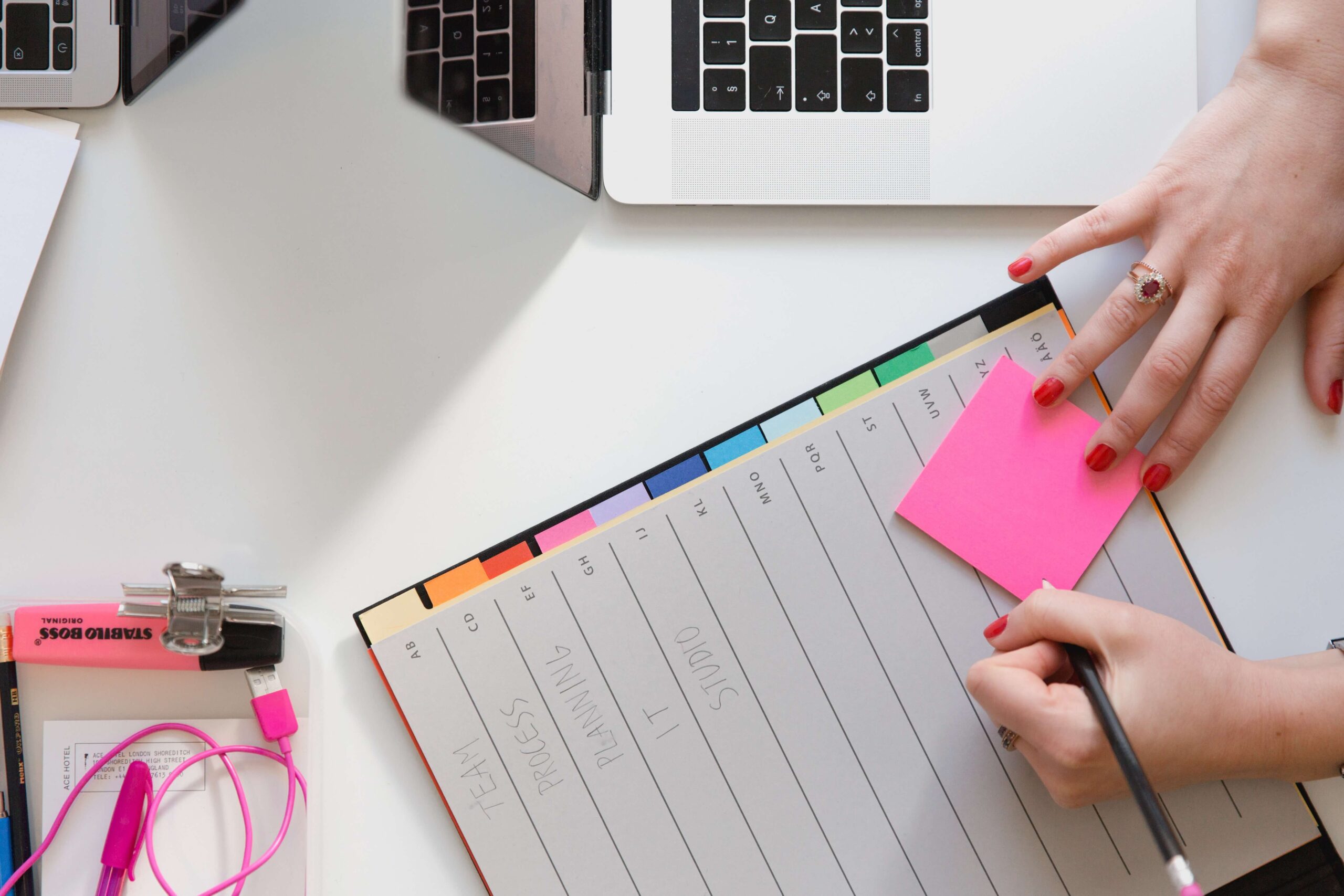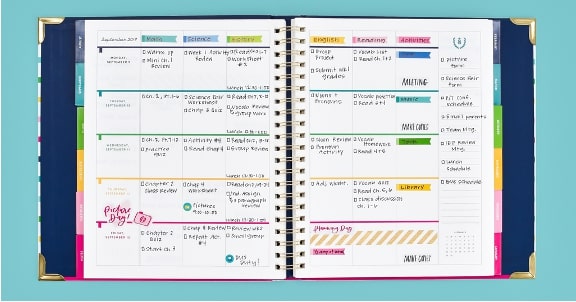Last month, we wrapped up our first virtual summit. Think a virtual summit sounds boring? Nothing at InterWorks is ever boring. You can read more about how our incredible team pulled off a virtual summit in record time, providing tons of professional development and increased team unity here.
The Value of Paper Planning
During the summit, I had the opportunity to present on a topic I am passionate about: paper planners. I can hear a few of you groaning. Kirsten, you work at a tech company. Why would you want to use a paper planner with so many digital products at your fingertips?
All true, friend. I do work for a tech company, and I readily embrace new technology, especially when it fits seamlessly into my life. I do use an Outlook calendar. There are definitely some things it’s great for: recurring meetings and keeping track of Zoom invitations. However, I find the perpetual nature of the digital calendar unnerving. I have a mini existential crisis whenever Outlook asks me how long I want this meeting to recur … forever?!
I also hate paper files so much that several years ago, I invested in a high-quality scanner so I could rid myself of clutter. Paper is messy, hard to organize and almost never in the right place when you need it. I have spent long hours creating files of all my electric bills, warranties and even birthday cards. Yes, I know how to party. I even convert all my son’s artwork into digital files, smuggling the physical paper to the recycling bin while he’s not looking. Yes, I am a digital hoarder.
So why are paper planners different? I have a few reasons.

There is a high level of nostalgia for me whenever I purchase a new planner. It evokes the start of a new year. While many people think of January 1st as New Year’s Day, the real new year in my mind is the start of a new school year—that August/September timeframe when summer wanes, and cooler temperatures abound. My love affair with planners started as an elementary school student who needed a way to keep track of assignments. Each new school year, a brand-new planner brought with it so much promise for the year ahead. Tabula rasa. A clean slate.
Full Focus
We spend so much time on screens where our focus is constantly interrupted. A new Slack message, a high-priority email, your child’s next Zoom call for distance learning … all are jockeying for your time when you are online. Paper planners allow you to disengage and focus on what you really want to accomplish in an hour, a day, a month.
Stepping away from the screen allows you the opportunity to slow down. There are countless studies on how multi-tasking leads to greater inefficiency rather than improving our productivity. Taking the time to walk away from our screens and determine our actual goals allows us to strip away the extraneous and focus on what is important to us. For me, focusing on what needs to get done helps alleviate anxiety. Instead of having an endless task list in my own brain, writing a plan for the day allows me the ability to prioritize, streamline and evaluate where my time is spent.

Intrinsic Rewards
Using a paper planner provides plenty of intrinsic reward when you can check off a task. Whether it’s finally documenting a process that’s been in place for the last three months, or you finally remembered to pick up the dry cleaning you dropped off pre-pandemic, it’s rewarding to see that you accomplished something. I don’t get the same level of satisfaction by using my cursor to check a box. Having the item listed in my planner allows me to look back and see what I have accomplished anywhere I take my planner.
Paper planning also makes staying organized simple. I never have to worry about having an Internet connection when I am using my planner to organize my busy life. I can break things down in smaller chunks and carry it with me without having to worry about charging it. In our digital world, this is a small but powerful way I can be independent of technology. Plus, you can hold on to a paper planner in a way that’s different than holding a phone, tablet or laptop. Lots of people rejected e-readers because they missed the heft of the book while they were reading. The tactile nature of using a paper planner gives the minor aspects of your life weight. And once a year or project is over, it’s satisfying to look back on a tangible planner, or stack of planners, as a symbol of your accomplishment.
It is proven that writing things down by hand helps you retain information better. The mere act of writing increases neural activity in certain sections of the brain, just like meditating. It’s also been found to unleash creativity not accessed in other ways. Sequential hand movements activate large regions of the brain responsible for thinking, language, healing and working memory. Handwriting has also been linked to sharpening your brain.
Transitioning to a Paper Planner
If I have captured your interest in trying a paper planner again, or using one for the first time, there are a few things to consider before you jump in. Simply purchasing a paper planner or creating your own (check out bullet journaling for more) is not enough to magically change your life. There is a little bit of work involved.
Benjamin Franklin—yes, founding father and polymath Benjamin Franklin—is one of the people that established best practices for using a planner. A printer by trade, Franklin was able to put his own printed books to use. He established some tenets that are still true for making this method work best. You need a disciplined personality, good time-management skills and be on a constant quest for self-improvement. (Those are also traits of many of our employees in case you are looking to join our team.)
Franklin established a routine that works well even today. Each morning he sat down with his planner with these three tasks:
- Sit down and reflect
- Practice gratitude
- Establish a focus for the day
In a similar fashion, at the end of the day, Franklin would sit down and determine what amongst his tasks was successful and where he failed. When he failed to complete something, he reviewed why he was not able to get that goal accomplished. This helped him reframe the task as either something that was not that important or something that had to be approached in a different method.

Above: A sample from Benjamin Franklin’s daily plan for himself
While you may not have the ability to spend quality time planning life each morning or afternoon, you can carve out time once a month for long-term goals, and once a week to plan your week for maximum effectiveness.
Most Sunday afternoons, I check out my planner to see what I have on deck for a given week. This gets me in the right head space for what needs to be accomplished. Using a paper planner takes a little work, but I find the rewards are worth the time investment.
Choose a Planner to Fit Your Needs
As someone who has been known to drop a pretty penny on the latest-and-greatest planner, I highly suggest you take some time and evaluate what you want from your planner.
Design
There are five groups that most planner professionals identify. Depending on what you want to get out of your planner, these areas can help you wade through the endless variety:
- Strict Scheduling – Tracking appointments and blocking out time for projects
- Goal Planning – Establish long-term goals and track them in bite-sized chunks
- Artistic Planning – Keeping a schedule with room for your doodles, tracking stickers, etc.
- Memory Keeping – Keeping a record of your schedule and the memories you made. Weddings, trips, etc.
- Super Customized – You choose specific layouts for the various parts of your life. Good for the person juggling all the things
If you have a fear of commitment, don’t worry. Lots of the major planners have printable samples you can try before you buy.
Cost
There are a wide variety of planners out there, from inexpensive homemade planners made out of a cheap spiral-bound notebook to $100 models that are flashy and promise to help you conquer your dreams. Like most products these days, there is an abundance of choice. You can find a planner in your budget.
Other Considerations
- Do you plan on carrying it with you?
- How big is your workspace?
- Do you like the material?
- Are the pages thick or thin?
- Do you write with ballpoint pens, fountain pens or felt-tip markers?
- Will the ink bleed through?
- Are you left-handed and find that right-handed spirals make you nuts?
Tips to Transition Strategically
- What are you tracking digitally?
- Are there some things that make more sense to track digitally and others to track on paper?
- Recurring tasks?
- Make a list of them and reference them when you are a planning a day, a week or a month.
Planner Recommendations
Need some help getting started on evaluating a planner? Check out the links below to find the one that works for you. I’m currently use a highly customized 8.5 x 11-inch planner from Plum Paper. One of my character flaws is a Leslie-Knope-like tendency to join any board, committee or task force that approaches me. The Plum Paper layout allows me to track work, my son’s schedule and the umpteen other things I should have turned down.
Whatever you decide, whether it’s to stick with tech organization tools or to venture into paper planning, I hope you find the time to reflect, dream and realize your goals.
Printable Pages to Try Out Different Styles
Links to Planners and Planner-Related Stores
- Appointed Planners
- At-A-Glance
- Boss Personal Planner
- Bullet Journal
- Day Designer (*Oklahoma-owned business)
- Emily Ley
- Erin Condren
- Get to Work Book
- Golden Coil
- Happy Planner
- The Happiness Planner
- Mochi Things
- The Paper Store
- Paper Source
- Passion Planner
- Golden Coil
- Typo Market (*local Stillwater store – home of InterWorks’ corporate headquarters)


